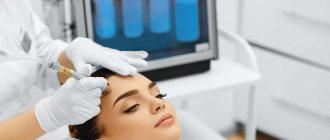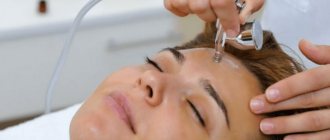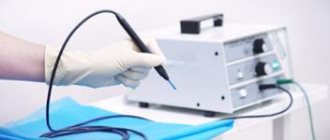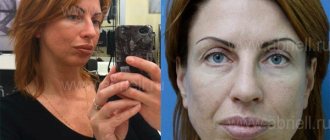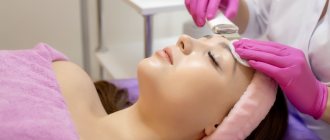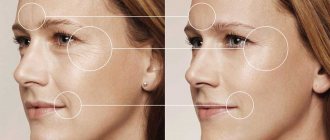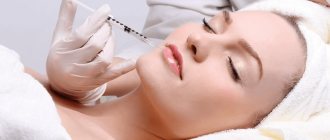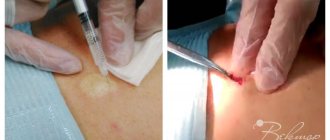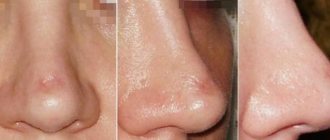Sweating is a natural body function necessary to regulate body temperature. However, excessive sweating (hyperhidrosis) indicates disturbances in the functioning of the sweat glands. Alas, this delicate problem is by no means uncommon; it can haunt people of all ages and genders, causing them not only physical discomfort, but also mental suffering. It is not surprising that all kinds of complexes and neuroses often become companions of hyperhidrosis.
Just a few decades ago there were no effective ways to cope with this scourge. However, the discoveries of modern medicine have given us the opportunity to reliably deal with excessive sweat secretion for many years and even forever.
You can read about the treatment of hyperhidrosis with Botox
This same article talks about the most effective method today - laser treatment for sweating .
How is laser treatment for hyperhidrosis performed?
Laser treatment of hyperhidrosis is considered a surgical procedure and is performed in an operating room under complete sterility. SM-Plastic specialists use a high-tech laser device SmartLipo (Italy) to eliminate excessive sweating.
The procedure itself is practically painless, but to eliminate any discomfort, local anesthesia is used, and, at the patient’s request, general anesthesia. Laser exposure to the problem area allows you to block the work of the sweat glands with pinpoint precision, without affecting the skin and surrounding tissues, which prevents bruising and swelling, and the rehabilitation period passes without much discomfort.
The duration of laser treatment for hyperhidrosis is from 1 to 1.5 hours. The procedure does not require a long hospital stay - if you follow the plastic surgeon’s recommendations, you can return to your usual activities on the same day.
Diagnosis of hyperhidrosis
A person presents characteristic complaints of increased sweating. The doctor at the appointment asks a lot of questions, trying to find out the cause of the disease. Then an additional examination is prescribed, including laboratory and instrumental methods, consultations with a neurologist and endocrinologist. The doctor determines the scope of the study individually for each patient.
To assess the severity of the disease, a Minor iodine-starch test is performed. The area of increased sweating is smeared with iodine, and after the painted area has dried, sprinkled with starch. After a certain time, the doctor assesses the size of the area covered with starch, blackened by sweat.
The gravimetric method allows you to accurately determine the volume of sweat released. To do this, a sheet of filter paper of a small area of known mass is placed on a dry human body. The sheet soaked with sweat (for a certain amount of time) is weighed again and the amount of sweat released per day is calculated.
To clarify the nature of the disease, a laboratory analysis of sweat is performed. Only when the cause of hyperhidrosis is established is treatment prescribed.
The effect of laser treatment for hyperhidrosis
The effect appears within a month. After the procedure, sweating is reduced by 90%, the specific odor disappears, and wet spots do not form on clothing in the armpit area. You will be able to give up antiperspirants and the feeling of discomfort that causes increased work of the sweat glands during physical activity and stressful situations.
In most cases, sweating in the treated area is not only reduced, but also stopped permanently. Occasionally, in case of severe disruption of the sweat glands, a repeat procedure may be required, which is carried out no earlier than after 2-3 months.
Causes of hyperhidrosis
- Diseases of the nervous system: vegetative-vascular (neurocirculatory) dystonia, various forms of neurosis.
- Problems of the endocrine system: disruption of the hypothalamus, diabetes mellitus, hyperfunction of the thyroid gland.
- Oncological diseases.
- Infections often occur latently, for example, tuberculosis.
- Chronic intoxication, including alcoholism and drug addiction.
- Autoimmune diseases.
- Rheumatism.
- Taking antidepressants.
The following factors provoke the state of hyperhidrosis in a healthy person:
- using warmer clothing than is necessary for the season;
- clothing made of synthetic fabrics that are poorly breathable;
- tight shoes made of artificial materials.
There is also hereditary hyperhidrosis.
How to treat hyperhidrosis at GarantClinic?
In the treatment of excessive sweating, the following areas are distinguished:
- Conservative methods ( local treatment of hyperhidrosis
- Injections of drugs based on botulinum toxin type A.
- Surgery.
For each of the presented methods aimed at curing hyperhidrosis , there are indications. All methods differ in the severity of the effect, its duration, and side effects. Our clinic practices injection techniques and performs surgical interventions for hyperhidrosis (curettage).
Contact us!
MAJOR CLINIC invites you to an appointment with a cosmetologist to get rid of the unpleasant symptoms of hyperhidrosis. We employ highly qualified specialists with successful experience in treating hyperhidrosis. They will conduct a thorough examination - the clinic has all the necessary laboratory and diagnostic equipment. They will determine the cause of the disease and help eliminate it.
To treat the disease, only certified products approved for use in Russia are used. In the absence of contraindications, Botox or Dysport are used. Our doctors masterfully master the technique of injecting botulinum toxins into any area of the body without the risk of developing any unpleasant side effects.
The price is determined individually and depends on many factors. Come to an appointment with a cosmetologist to talk about your problem, outline an examination plan and find out the estimated cost of treatment. You can sign up by phone or directly on the website.
Features of the course of hyperhidrosis
As the pathology develops, sweat is released frequently and profusely, even in a cool room and in the absence of physical activity. The patient observes the appearance of a sweat odor and wet clothing in problem areas.
The disease is characterized by seasonality, but it does not always manifest itself. But in most cases, patients note increased sweat production in spring and summer.
Most often, sweating occurs during moments of stress or physical exertion. Less common is constant increased sweating, regardless of the provoking factors.
Five most popular questions about hyperhidrosis
They say that after the injection, sweating disappears under the arms, but appears in other places?
The injection blocks the nerve impulse to each sweat gland. Therefore, after the injection, compensatory sweating does not occur in other parts of the body.
Is the procedure painful?
The procedure is painless, because performed under local anesthesia.
How long does the effect last?
The result lasts up to 6 months. The procedure is very effective for the armpits, palms and feet.
The feet are very sweaty. I tried making baths with a decoction of oak bark. The effect is very weak. Can Botox help?
Yes, treatment with botulinum toxin preparations gives a very good effect for your problem. Read reviews from our patients. Come for a consultation.
Why surgery is needed
Hidradenitis is an inflammatory and purulent process affecting the apocrine sweat glands. The causative agent is predominantly Staphylococcus aureus, which penetrates the gland against the background of microtrauma of the skin, concomitant skin diseases and insufficient personal hygiene. The disease also occurs due to the abnormal anatomy of the sweat gland - a narrowed, tortuous duct is systematically blocked by sebaceous secretions and keratinized skin particles, which leads to a recurrent inflammatory process. An infiltrate develops, followed by melting of the surrounding tissue.
Hidradenitis differs from other purulent-inflammatory processes of the skin and subcutaneous structures in the absence of a necrotic core. Staphylococcus aureus provokes necrosis of sweat gland tissue. After their destruction, the cavity filled with purulent contents and necrotic masses increases. The infiltrate turns from dense to soft, and pus appears through the thinned skin.
At this stage, it is necessary to surgically open the abscess, otherwise the likelihood of the disease becoming chronic and the development of such serious complications as sepsis, the formation of purulent foci in the internal organs, etc. increases. Conservative therapy is aimed at rapid maturation of the infiltrate. The main method of treating the disease is surgical.
Primary axillary hyperhidrosis
Primary axillary hyperhidrosis (PAH), or excessive sweating limited to the axillary region, is a debilitating condition that has a negative impact on a person's social and psychological well-being.
Several approaches have been developed for the treatment of PAG, including antiperspirants, systemic anticholinergic drugs, laser and surgical methods for removing sweat glands, for example, by direct resection of the skin area, liposuction, curettage, etc. All these options, as clinical experience shows, provide varying effectiveness and therapeutic benefits. deadlines.
The use of botulinum toxin type A injections is a widely used minimally invasive treatment for PAG. Its limitations include discomfort, relatively high cost, and the temporary effect of injections (3–6 months). Long-term results (12–14 months) have been reported using a device that generates microwave energy at the interface of the epidermis and subcutaneous fat, which causes irreversible thermolysis of apocrine and eccrine sweat glands.
Recent studies have suggested an alternative treatment option for primary axillary hyperhidrosis with objective long-term results. Studies suggest that high-intensity focused fractional radiofrequency ( HIFRF ) can be used in the treatment of PAG. When used to treat other dermatological conditions, HIFRF has also shown a superior safety profile compared to conventional RF therapy.
Suction curettage for sweating
Today we will talk about “armpit liposuction” - curettage
, as an option for the treatment of axillary hyperhidrosis with candidate of medical sciences, thoracic surgeon and specialist in this matter,
Vladimir Aleksandrovich Kuzmichev
.
Vladimir Alexandrovich, tell our readers what curettage of the armpits is and why it is sometimes called “armpit liposuction”?
Curettage is a derivative name derived from the instrument used to perform this operation. This is a regular gynecological curette, which scrapes the skin from the inside, cleansing the deep layer of the dermis in which the sweat glands are located. This is one of the simplest methods to treat underarm sweating. This operation is not quite correctly called “armpit liposuction”. This naming was based on the fact that during a curettage operation an instrument that can also be used to perform liposuction can be used. Externally, curettage is similar to liposuction, although the effect is different: not the removal of fat cells, but the removal of the inner layer of skin in combination with aspiration and vacuum.
How is the operation performed?
The operation is usually performed under local anesthesia. The patient lies with his hands behind his head. Abundant infiltration of the axillary zones with an anesthetic is performed in combination with a minimal amount of adrenaline. This is done to reduce bleeding. In addition, infiltration is created as if “pads” in the armpit area. Thus, we achieve an anesthesia effect and lift the skin above the axillary tissue, thereby making the operation absolutely safe in terms of possible damage to blood vessels, etc.
Are the incisions large?
No, a small incision of about 1 cm is made, where the skin is subsequently separated with a special tool. The surgeon makes a kind of tunnel: the skin of the area of the hairy part of the armpits is separated, a curette is inserted, which is connected to a vacuum pump, and the area of the hairy part of the armpits is evenly cleaned.
The operation is completed when the skin is thin enough that the curette is practically “see-through.” At the same time, a skin reaction is also noted: it turns red and some irritation appears. It is important for the surgeon to understand that enough action is being taken to both avoid damaging the skin and at the same time remove enough tissue from underneath the skin.
And how long does such an operation take?
The operation lasts about 40 minutes in total: 20 minutes on each side, with 10 minutes spent on infiltration and waiting for the effect of anesthesia to take effect. After the operation, drains are installed in the armpit area, through which residual fluid is released. Finally, the operated area is bandaged. After the operation, the patient spends the night in the clinic.
With your hands behind your head?
No, your hands are already free. The next day, before discharge, the drains are removed. But for the next three days, we recommend bandaging fairly tightly so that the skin that has separated is pressed tightly to promote maximum healing. If you do not follow this rule, then deep abrasions may appear on the skin of the armpits, which, of course, heal, but leave scars (so-called de-epidermization of the skin).
Is healing painful?
No, if there are any unpleasant sensations, they can be relieved with painkillers. And, as already mentioned, tight bandaging is mandatory for several days.
How long after surgery can you use and is it necessary to use deodorants, antiperspirants, shave your armpits, depilate...?
It all depends on whether complete healing has occurred. If the rehabilitation period went well, then after a week there are no problems with the armpits. The stitches are removed on the 7th day, and you can begin the necessary procedures.
Should the patient be seen by a doctor during the recovery period?
Here we allow patients to do their own dressings and contact us if they have any questions, especially related to poor skin healing.
How long does the effect of the operation last?
The maximum effect of the operation, if achieved, lasts for three to four months, after which a certain return of slight sweating occurs, which already persists for a very long time, one might say, for life. It should also be said here that the sweat glands can be completely removed only if the armpit area and the scalp are excised. The operation of curettage does not allow complete removal of the glands.
Sweat glands are an inevitable component of the skin structure; if we remove the entire area, we leave the skin without blood vessels, without underlying tissue, i.e. only one epidermis, which cannot “survive” on its own. Then the patient will just have one big scar, which, as you understand, is bad.
It is also worth noting that the idea of localized removal of deep layers of skin to treat hyperhidrosis has evolved over time. Many modifications of this operation have been proposed, which were mainly based on the desire of doctors to get away from skin excision surgery. Then there were many modifications using laser and ultrasound, which did not quite pay off. All of these methods developed before the advent of botulinum toxin type A. The advent of botulinum toxins led to a sharp decline in the use of local surgery to treat hyperhidrosis. I would even say that now patients resort to curettage surgery for armpit sweating, when antiperspirants do not help, and botulinum toxin injections are either expensive or do not help either.
Is it possible to give botulinum toxin injections after curettage, for absolute dryness? How long after the operation?
Yes, you can. If the patient is convinced that the effect has not been fully achieved, then after a month, botulinum toxin can be injected into the armpits.
How long do botulinum toxins last in the armpits?
On average 6 months, but it can be 8-10 months, or even a year and a half.
How long does the result after armpit curettage last?
In my practice, there are patients whose results last for more than 10 years. And there are patients who had repeated curettage several years later. Here it is individual, as well as with the duration of action of botulinum toxins.
How long does it take to repeat curettage?
As a rule, after a year. The earliest is in six months. After a year, mainly in the case when the required effect is not achieved. The third time, curettage is almost impossible to do without damaging the skin.
What is your opinion about laser treatment of hyperhidrosis using the Smart Lipo device?
Smart Lipo gives a certain dryness to the armpits and I had to use this device in my practice, but later we abandoned its use. I'll explain why. It’s not that we didn’t see any striking differences compared to conventional aspiration curettage, but even patients noted a weaker effect!
Even today, patients often come to me with the hope that Smart Lipo will give them results immediately and forever. Hopes are not justified. My experience in communicating with foreign colleagues indicates that laser treatment of the sweat glands is not currently used on its own, but, as a rule, is used as an addition to conventional or aspiration curettage.
Those. Western and American doctors don’t treat with laser?
In Western Europe and America, needles are now becoming popular, which are inserted into the dermis with a special device (MiraDray). With this method, the effect of microwave destruction of sweat glands occurs. It is still difficult to say how the skin will behave, but, nevertheless, this is a new technology that may displace other methods of treating sweating. In my opinion, at the moment, the most comfortable method for the patient is botulinum toxin injections.
We can block the sweat glands (reduce sweating) solely by removing the sweat glands. But they cannot be removed in isolation: in any case, some nearby tissues are destroyed. Therefore, based on the very structure of the skin, we can say that the full effect of dryness cannot be achieved.
Why do some patients undergo curettage, others receive butolotoxin injections, and others are recommended antiperspirants? Does the prescription depend on the physiological characteristics of the patient?
I would say the smartest thing to start with is medical grade antiperspirants. If they help, then in my opinion this is the best method.
If a patient suppresses the sweat glands for 3-4 years using concentrated aluminum chlorides (medical antiperspirants), then by this time atrophy of the sweat glands occurs and sweating stops. Therefore, it is wrong to treat antiperspirants as a “non-therapeutic” method; this is, in fact, a method that can lead to a complete cure for excessive sweating. But the application of antiperspirants is sometimes accompanied by itching and burning, so many patients do not like it. In this case, the method of injecting botulinum toxins is very convenient, which allows you to achieve certain effects for some fairly long time (six months to a year).
But is curettage still more cost-effective than injecting Botox?
Yes, curettage is more profitable financially, but the completeness of the dryness effect with botulinum toxins is higher.
Vladimir Alexandrovich, at the end of our conversation, I would like to hear your recommendations for those who suffer from armpit hyperhidrosis. How can they fight this disease?
Here you need to evaluate why you are not using antiperspirants: either they do not work, or there is a reaction. For what reason do you not do botulinum toxin? Many prejudices about antiperspirants (“use causes cancer” is a myth) and botulinum toxins are unfounded and mythical. And only if you persistently do not want to use these two methods, then you are left with curettage.
Thank you very much, Vladimir Alexandrovich, for the valuable information! Have a nice day and see you again!
Make an appointment
Botulinum toxin injections
Botulinum toxin injections in the treatment of hyperhidrosis are recognized by experts as an alternative, safe and highly effective method. The anhydrotic effect is achieved by triggering a mechanism to inhibit acetylcholine transmission at the junctions between nerve and muscle cells. The toxin begins to work already on the third day, the maximum result appears a week after the procedure. If Botox is chosen, then 50 to 100 units are required for one palm or armpit. Excessive sweating will not occur until 20 weeks if the injections were performed in the palm tissue, and until 32 weeks if in the armpit. Many patients note that at the end of the procedure, sweating is less than they had before the start of treatment.
Side effects include pain during injection, mild muscle weakness and small bruises. The first of the undesirable effects can be prevented by using an anesthetic cream. It is especially important to perform high-quality anesthesia in the form of a nerve block for plantar hyperhidrosis, especially since in this localization surgical operations are undesirable and it is necessary to achieve a good effect by injecting botulinum toxin: Botox or Dysport.
Technique of the procedure
After examining the person, the doctor begins preparing the skin for injections. First, the skin is cleaned of contaminants and treated with an antiseptic solution. Next, the area is treated with an anesthetic cream containing lidocaine. After a few minutes, the specialist can begin directly injecting the drugs under the skin.
The effect of the procedure occurs after 1-2 days and reaches its maximum on about the 5th day. Small hematomas and redness of the skin may appear at the injection sites. These side effects disappear on their own within 2-3 days.
Operating principle
An effective, 100% safe and reliable method of treating hyperhidrosis is offered by specialists at the ROSH medical center - injections of purified botulinum toxin A. When administered, the drug blocks the transmission of impulses from nerve endings that regulate sweating to the sweat glands.
The result is a complete suppression of their activity for a period of 6 to 8 months, depending on the characteristics of your body. Within 7-10 days after botulinum therapy, you will forget about the problems associated with excessive sweating. The entire procedure, including examination and preparation, takes no more than 1 hour.
Why should you contact the Innovative Medical Center to treat hyperhidrosis?
Our Center has created all the conditions for botulinum therapy and treatment of hyperhidrosis.
Our medical center employs an experienced cosmetologist with 21 years of experience, Sylvia Yakovlevna Tsaturyan, Candidate of Medical Sciences, who has a certificate for performing injections with botulinum toxin preparations and only positive reviews from patients.
Silvia Yakovlevna is a participant in Russian and international congresses and scientific and practical conferences on plastic surgery and cosmetology (Rhodes 2009, Barcelona 2010, Beijing 2011, Santiago 2013, Costa Brava 2014, Issyk-Kul 2017).
(more about the doctor).
Therefore, consultation and procedure with us is a guarantee that:
- you will be recommended the optimal preparation and number of units based on your skin type, age characteristics and correction area;
- For the procedure, the drug will be used only from official distributors. In our medical center for injections we use the Top 3 high-quality drugs that have proven themselves excellent in clinical practice: Botox (Botox®) - purified neurotoxin complex of botulinum toxin type A (Allergan, USA);
- Dysport® (Beaufour Ipsen Ltd, UK);
- Xeomin® (Merz, Germany);
Indications and contraindications
Treatment of sweating (hyperhidrosis) with Botox is prescribed for increased sweating in various parts of the body, including the armpits, feet and palms, buttock folds, intimate area, as well as the forehead and head. The number of units of the drug is calculated taking into account the area of the treated surface.
- Indications:
- generalized hyperhidrosis,
- local hyperhidrosis,
- increased sweating with an unpleasant odor.
Before starting injection treatment for hyperhidrosis, an examination is carried out in the clinic. The specialist examines the problem area, diagnoses the extent of the disease, and also makes sure there are no contraindications. This ensures 100% safety and effectiveness of the procedure.
- Contraindications:
- individual intolerance to the components of the drug,
- myasthenia gravis,
- hemophilia,
- pregnancy and lactation period,
- infectious diseases,
- oncology.
Note! If you have taken antibiotics in the last 14-21 days before your procedure, please tell your specialist.
Diagnostics
During the examination of the patient, the doctor determines whether increased sweating is a symptom of any pathology or a normal reaction of the body to external stimuli. The diagnosis is usually made after taking a history and interviewing the patient.
The following factors can confirm the presence of primary hyperhidrosis:
- The problem appeared in childhood.
- Signs of hyperhidrosis are observed among family members.
- Sweat is produced regardless of physical activity and sports.
- There were no symptoms of chronic diseases or infections.
However, after this it is important to exclude the presence of endocrine disorders and kidney diseases. To do this, the patient is prescribed a consultation with relevant specialists and certain tests (including a general and biochemical blood test, glucose test, hormone testing, HIV and syphilis tests, urinalysis).
